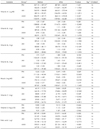Abstract
The effects of unripe apple mask pack made from unripe apple extracts on the skin status of middle-aged women for 4 weeks were investigated. The subjects were divided into three groups: placebo mask pack as the control (PM, n = 8), apple mask pack (AM, n = 16), and apple mask pack + apple intake (AAM, n = 12). The study included a survey questionnaire, and evaluations of nutrients intakes and of skin status. Skin status was measured by Aramo-TS. After 4 weeks, facial moisture, elasticity, evenness, and wrinkle level were improved in AM and AAM. The facial moisture level (AM: +3.13 ± 2.73, AAM: +2.25 ± 2.93) and elasticity level (AM: +5.81 ± 8.27, AAM: +5.50 ± 6.13) of AM (p < 0.001) and AAM (p < 0.05) were increased. The facial evenness level (AM: -5.25 ± 8.13, AAM: -9.17 ± 4.26) and wrinkle level (AM: -10.88 ± 11.74, AAM: -17.83 ± 12.22) were significantly decreased. AAM was more effective in improving skin elasticity, evenness, and wrinkle. The skin status of PM was not changed. While the macronutrient intakes of all the subjects were not different before and after the study, the daily intakes of some vitamins (vitamins B6, C, and E and folic acid) during the study were significantly increased in AAM. These findings suggested that regular use of apple mask pack was effective in improving overall skin status. Furthermore, the consumption of apples with mask pack application was much better in improving skin status.
Figures and Tables
References
1. Kim SR, Yoo TS. The relationships between the extent of women's skin care by clothing behavior and self-efficacy. J Korean Soc Cloth Ind. 2005. 7(4):413–418.
2. Lee SH, Lee KY, Kim SO. Effects of skin care on users' mental health and self-esteem. J Korean Soc Cosm. 2009. 15(1):155–167.
3. Kim YS, Park JY. The Analysis on appearance management of male college students: Focused on management of hair, skin, cosmetic surgery, fashion and body shape. Korean J Human Ecol. 2009. 18(1):259–273.

5. Kim KY, Koh HJ, Kim KY, Jang MJ. Esthetics I. 1997. Seoul: SooMoon-Sa;249–264.
6. Seo JY. Skin aging from phenotype to mechanism. Korean J Investig Dermatol. 2001. 8(4):187–194.
7. Yasui H, Sakurai H. Age-dependent generation of reactive oxygen species in the skin of live hairless rats exposed to UVA light. Exp Dermatol. 2003. 12:655–661.

9. Fisher GJ, Datta S, Wang Z, Li XY, Quan T, Chung JH, Kang S, Voorhees JJ. c-Jun-dependent inhibition of cutaneous procollagen transcription following ultraviolet irradiation is reversed by all-trans retinoic acid. J Clin Invest. 2000. 106:663–670.

10. Fisher GJ, Kang S, Varani J, Bata-Csorgo Z, Wan Y, Datta S, Voorhees JJ. Mechanisms of photoaging and chronological skin aging. Arch Dermatol. 2002. 138:1462–1470.

11. Nichols JA, Katiyar SK. Skin photoprotection by natural polyphenols: anti-inflammatory, antioxidant and DNA repair mechanisms. Arch Dermatol Res. 2010. 302:71–78.

12. Korkina LG, Pastore S, Luca CD, Kostyuk VA. Metabolism of plant polyphenols in the skin: Beneficial versus deleterious effects. Current Drug Metabolism. 2008. 9:710–729.

13. Khanizadeh S, Tsao R, Rekika D, Yang R, Charles MT, Rupasinghe V. Polyphenol composition and total antioxidant capacity of selected apple genotypes for processing. J Food Compost Anal. 2008. 21:396–401.

14. Akazome Y. Characteristics and physiological functions of polyphenols from apples. Biofactors. 2004. 22:311–314.

15. Cheon HY, Heo SY. The Change of moisture and oiliness after applying natural skin care packs. J Beauty Trichology. 2008. 4(2):209–214.
16. Awad MA, De Jager A. Relationship between fruit nutrients and concentrations of flavonoids and chlorogenic acid in "Elstar" apple skin. Sci Hortic. 2002. 92:256–276.
17. Lee KW, Kim YJ, Kim DO, Lee HJ, Lee CY. Major phenolics in apple and their contribution to the total antioxidant capacity. J Agric Food Chem. 2003. 51:6516–6520.

18. Casagrande R, Georgetti SR, Verri WA Jr, Borin MF, Lopez RF, Fonseca MJ. In vitro evaluation of quercetin cutaneous absorption from topical formulations and its functional stability by antioxidant activity. Int J Pharm. 2007. 328(2):183–190.

19. Casagrande R, Georgetti SR, Verri WA Jr, Dorta DJ, dos Santos AC, Fonseca MJ. Protective effect of topical formulations containing quercetin against UVB-induced oxidative stress in hairless mice. J Photochem Photobiol B. 2006. 84(1):21–27.

20. Sharma SD, Meeran SM, Katiyar SK. Dietary grape seed proanthocyanidins inhibit UVB-induced oxidative stress and activation of mitogen-activated protein kinases and nuclear factor-κB signaling in in vivo SKH-1 hairless mice. Mol Cancer Ther. 2007. 6:995–1005.

21. Bagchi D, Bagchi M, Stohs SJ, Das DK, Ray SD, Kuszynski CA, Joshi SS, Pruess HG. Free radicals and grape seed proanthocyanidin extract: importance in human health and disease prevention. Toxicology. 2000. 148:187–197.

22. Khanna S, Roy S, Bagchi D, Bagchi M, Sen CK. Upregulation of oxidant induced VEGF expression in cultured keratinocytes by a grape seed proanthocyanidin extract. Free Radic Biol Med. 2001. 31:38–42.

23. Bagchi D, Garg A, Krohn RL, Bagchi M, Bagchi DJ, Balmoori J, Stohs SJ. Protective effects of grape seed proanthocyanidins and selected antioxidants against TPA-induced hepatic and brain lipid peroxidation and DNA fragmentation, and peritoneal macrophage activation in mice. Gen Pharmacol. 1998. 30(5):771–776.

24. Zhao J, Wang J, Chen Y, Agarwal R. Anti-tumor-promoting activity of a polyphenolic fraction isolated from grape seeds in the mouse skin two-stage initiation-promotion protocol and identification of procyanidin B5-3'-gallate as the most effective antioxidant constituent. Carcinogenesis. 1999. 20:1737–1745.

25. Shoji T, Masumoto S, Moriichi N, Kobori M, Kanda T, Shinmoto H, Tsushida T. Procyanidin trimers to pentamers fractionated from apple inhibit melanogenesis in B16 mouse melanoma cells. J Agric Food Chem. 2005. 53(15):6105–6111.

26. Kim MY, Cho KD, Beak OH, Lee BH. Effects of body composition, nutrient intakes and biochemical indices on skin health status of female university students with sensitive skin. Korean J Food Cult. 2008. 23(2):258–267.
27. USDA nutrient database for standard reference, release 22. US Department of Agriculture, Agricultural Research Service. Accessed Jul 20, 2010. Available from: http://www.nal.usda.gov/fnic/foodcomp/search.




 PDF
PDF ePub
ePub Citation
Citation Print
Print









 XML Download
XML Download